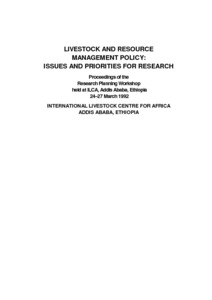Participatory planning of appropriate rainwater harvesting and management techniques in the central rift valley dry lands of Ethiopia
Despite the extensive efforts of rainwater harvesting and management (RWHM) interventions for moisture-stressed areas in Ethiopia, the adoption and wider dissemination of the newly introduced techniques have been generally meager. The objective of this study was, therefore, to develop appropriate RWHM techniques through a participatory planning process in the Central Rift Valley (CRV) dry lands of Ethiopia. To achieve this objective, a combination of literature reviews, focus group discussions, questionnaire surveys, agro-meteorological analyses and field experimentations were undertaken.
Participatory research on water and soil conservation, rangeland and livestock management
Research conducted in Mauritania.
Pastoral systems research
Selection of presentations made at the workshop on "Pastoral systems research in sub-Saharan Africa", describing the framework used by ILCA for pastoral systems research (PSR), examining methods used in the descriptive and diagnostic stage of PSR, and showing how the design and testing procedures are followed in practice; with particular reference to low-altitude aerial surveys, livestock surveys & household studies.
Pastoral systems research in sub-Saharan Africa
Presents a collection of conference papers defining pastoral systems research; the survey and diagnostic phase of pastoral systems research; ILCA's experience in remote sensing techniques and aerial surveys; survey of vegetation resources; livestock productivity and animal nutrition; pastoral production strategies, wealth effects, household studies, and labour data collection as well as livestock marketing studies.
Penataan ruang untuk memperkuat hak properti masyarakat
Policy issues and priorities for ILCA technology research
Animal agriculture can add to agricultural development through income generation, intensification, foreign exchange earnings and non-agricultural development. The primary justification for being concerned with animal agricultural in sub-Saharan Africa at present is the need to increase farmer incomes. Technological change is the primary means of raising farmer incomes. However, while new technology is a necessary ingredient in the process of agircultural development, it is not sufficient without conductive policy.
Potential environmental impacts
As the problems of impact assessement are rather intractable, a fairly simple dual approach is proposed. First the major components of environmental impact of current agricultural production systems in Africa (i.e. impact of cropping, livestock keeping, fuelwood and timber extraction and burning) are summarised. Second, "danger zones" in which current and future environmental impacts will be most severe and on which ILCA has focused its problem solving-research is identified.
Potential for impact: ILCA looks to the future
Presents papers discussing the potential for impacts within ILCA's organisational framework and mandate. The introductory paper raises general issues and poses questions that are pursued in the other papers. These papers address the environmental, economic and social components of impact within the organisation. Case studies on ILCA's research on tenure policy and alley farming, forage legumes, animal traction, milk processing, hay making and studies on pricing policies, technology generation and ILCA's research networks are presented in the papers.
Potential for increasing producers' income from wool, fibre and pelts in Central Asia
The systems of livestock production, marketing and research have been profoundly transformed by recent policies in Central Asia since the break up of the Soviet Union. Decollectivisation of state farms has transferred livestock ownership to new private farming units. These receive little or no state support for inputs, or for processing and selling livestock products. Most livestock-keeping families have much-reduced incomes compared to the Soviet period.
Plant breeding and the nutritive value of crop residues. Proceedings of a workshop
Presents papers dealing with the use of crop residues as livestock feed in smallholder crop/livestock farming systems, and the role of plant breeding in maintaining or improving their nutritive value. Discusses factors limiting the nutritive value of crop residues, and the effect of genotype and environment on the nutritive value of crop residues. Outlines perspectives and implications for crop improvement programmes. Includes recommendations.









